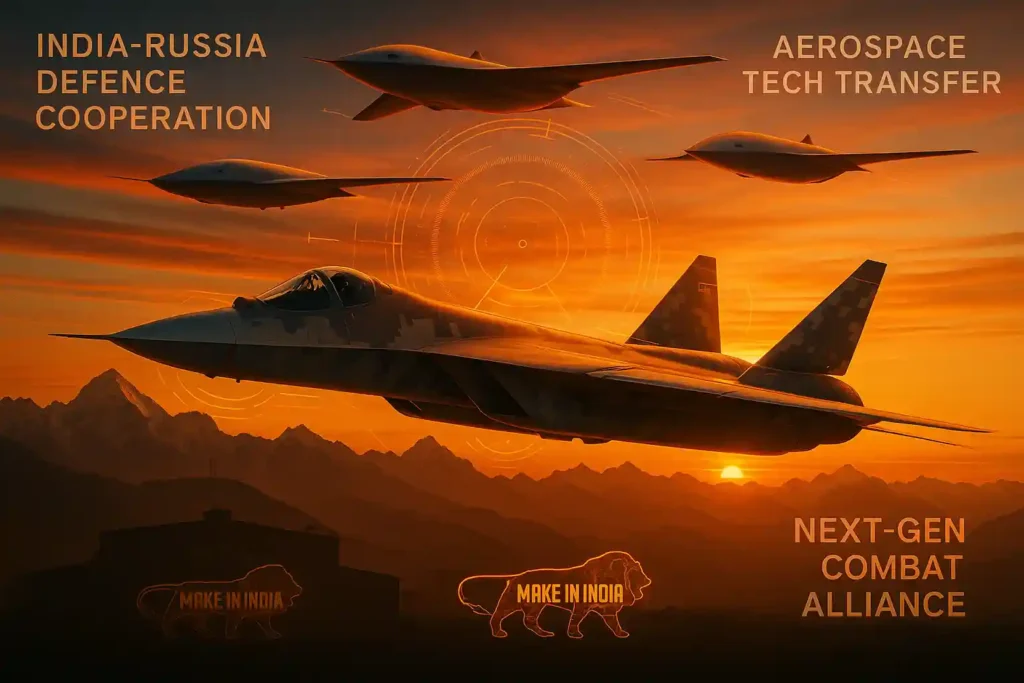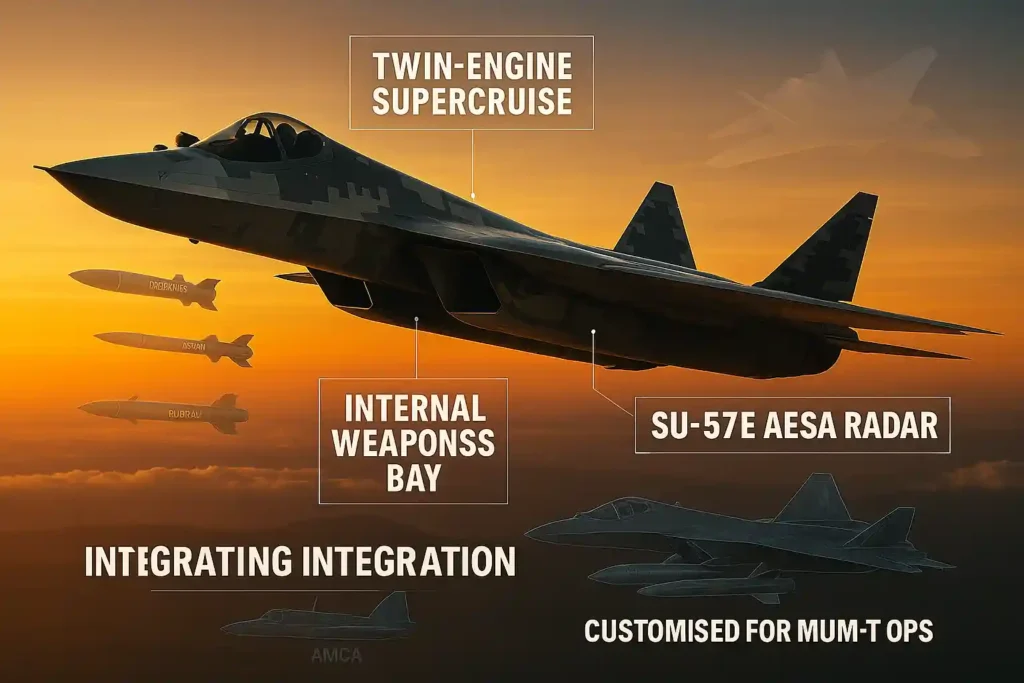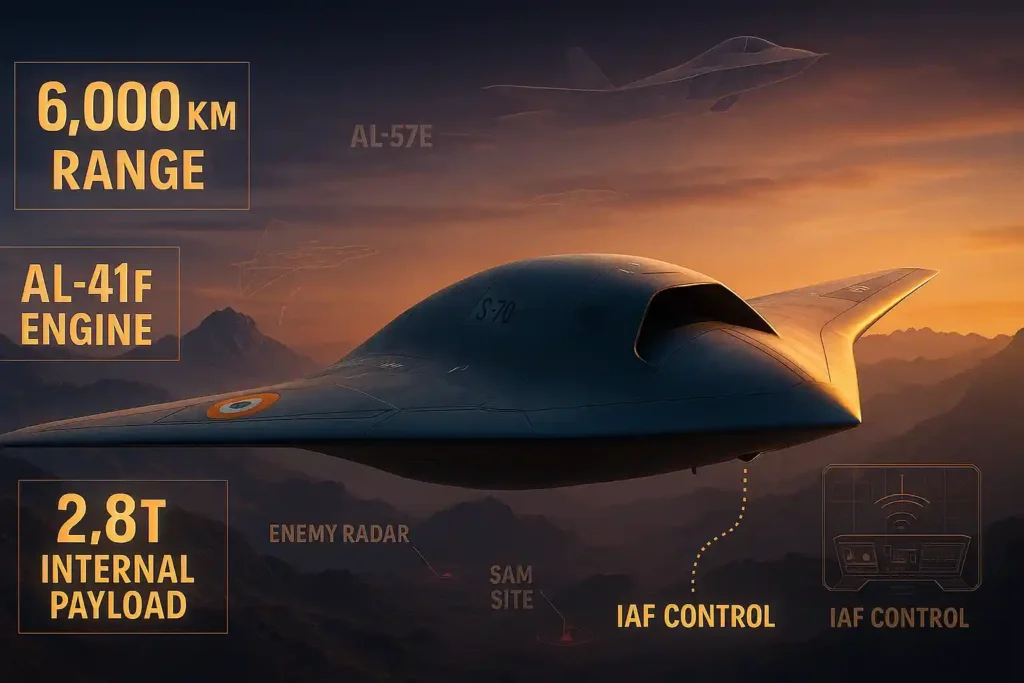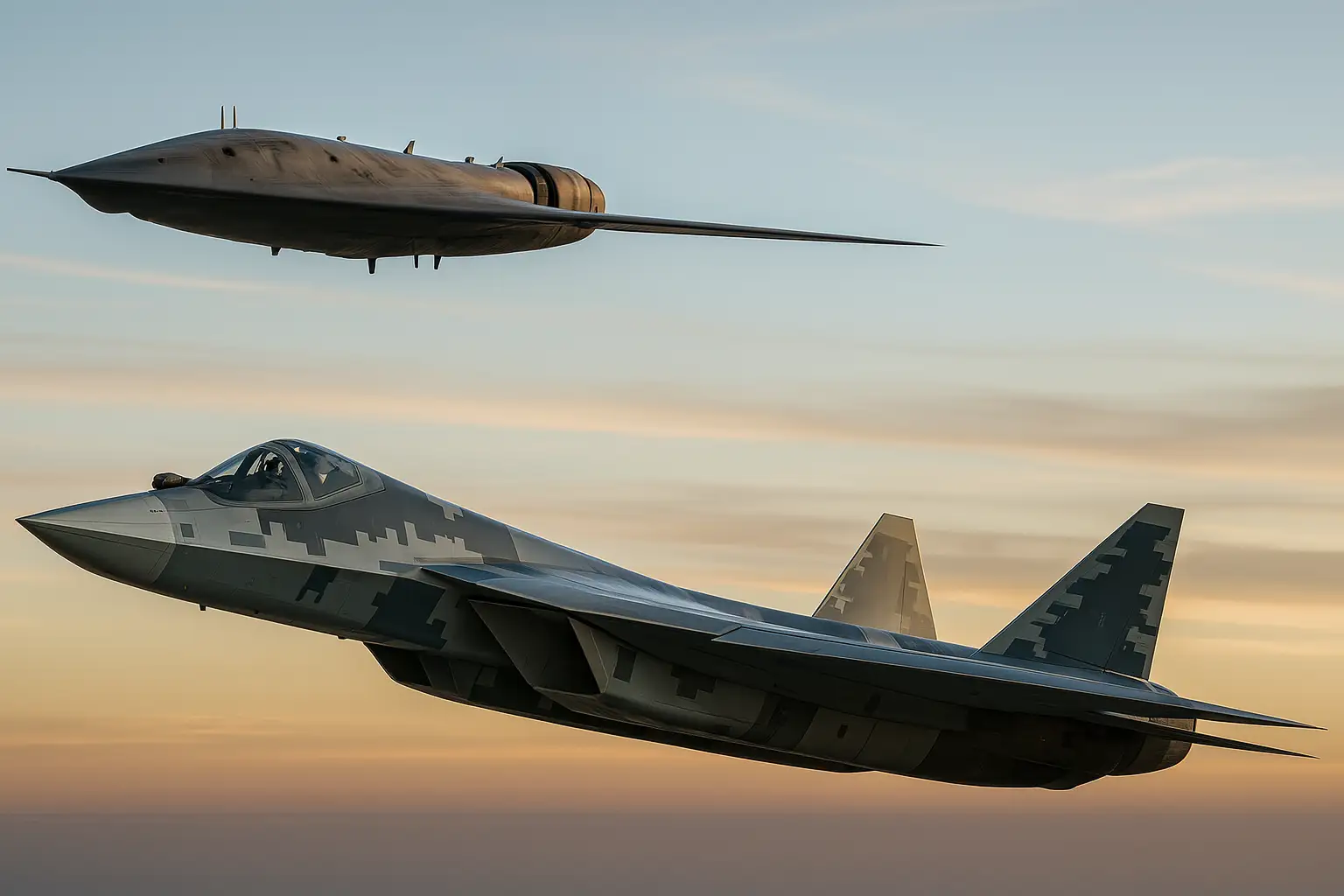There comes a moment in every nation’s defence journey when decisions are driven not by cost or convenience, but by vision and foresight. Right now, India stands at that critical juncture. And the trigger? The strategically timed offer of the Su-57E and Okhotnik-B for India, a move widely seen as Russia’s answer to growing U.S. influence in the Indo-Pacific.
As someone who has closely followed India’s defence transformation, and drawing from trusted insights within our DefenceNewsIndia sources, I believe this proposal is about more than just cutting-edge platforms. The Su-57E and Okhotnik-B for India represent a bold step, a leap in capability, strategic confidence, and calculated risk that could reshape the Indian Air Force’s future.
In this analysis, I’ll break it down, not just in terms of tech, but in what it means for India’s strategic posture in a shifting global order.
Why the Su-57E and Okhotnik-B Combo Matters Now
Understanding the Bigger Picture
With the IAF phasing out MiG-21s and facing two assertive neighbours, India needs more than incremental upgrades. The Rafale gave us breathing space. But if we want dominance in the coming decade, Indian Air Force modernisation must be bold and future-facing.
This is where the Russia-India MUM-T fighter drone deal makes sense. Not only does it address current gaps, but it also pushes India into the next generation of air combat.

What’s On the Table?
Russia offers:
- The Su-57E export variant, a Russian fifth-generation fighter
- The S-70 Okhotnik-B UCAV for the Indian Air Force, a stealth-class, long-range, heavy flying wing combat drone
- Full aerospace technology transfer
- Local production via HAL Nashik fighter production
- Seamless integration with India’s mission computer, weapons, and Uttam AESA radar
And most importantly, the chance to master manned-unmanned teaming (MUM-T).
The fact that Russia offers Su-57E and Okhotnik-B combo to India at this scale shows their readiness to deepen India-Russia defence cooperation beyond transactional arrangements.
The Fighter: Su-57E Stealth Jet for IAF
The Su-57E stealth fighter for the IAF comes with:
- Twin-engine supercruise jet performance
- Su-57E AESA radar (swappable with Indian systems)
- Internal weapons bay to reduce radar signature
- Compatibility with Indian weapons: Astra, Rudram, and BrahMos
- A potential Su-57E two-seater fighter with UCAV command capability, tailored for advanced manned-unmanned teaming missions

After being once rejected in the FGFA phase, this version of the Su-57E is now offered with a blank slate, ready to be customised by Indian engineers. That’s a massive shift.
From a user perspective, this offers flexibility. India isn’t just buying a black box; we’re shaping the future of the platform. That’s rare in global defence deals. Moreover, this could become a testbed for future systems destined for AMCA.
The Wingman: Okhotnik-B UCAV Specifications
The Okhotnik-B isn’t just a drone. It’s a statement of autonomous power.
- Stealth UCAV with 6,000 km range
- 2.8-tonne internal weapons bay
- Operates independently or alongside Su-57E
- Powered by the proven AL-41F engine
- Ideal for ISR, jamming, and deep precision strikes into enemy territory

For me, the Okhotnik-B loyal wingman for Su-57E India pairing is what truly makes this offer futuristic. Having a heavy, stealth UCAV that flies with a fighter gives India unmatched strategic reach.
The S-70 is not just another unmanned drone; it brings high-end performance previously restricted to manned aircraft. The ability to integrate it into India’s existing air command network will allow for significant operational depth.
This drone offers India its first true leap into long-range, stealth, and autonomous strike capabilities.
How MUM-T Changes the Game
Let’s talk tactics. In a manned-unmanned teaming scenario, one Su-57E can direct a group of Okhotnik-Bs. The fighters stay safe while the UCAVs do the dirty work: jamming radars, destroying SAMs, or gathering real-time data.
We saw a glimpse of such doctrine during Operation Sindoor, where precision, range, and electronic warfare shaped the battlefield. Imagine repeating that with stealth UCAVs flying 6,000 km into enemy territory without refuelling.
It’s not just smart. It’s survival-focused.
For India, MUM-T isn’t just a tech upgrade; it’s a shift in how the Indian Air Force thinks, trains, and fights. Our current air doctrine has slowly begun embracing autonomy, and this combo can accelerate that transformation. It also sets a solid foundation for future swarm drone warfare, where a single fighter coordinates dozens of AI-enabled UCAVs.
This is where the Su-57E and Okhotnik-B for India becomes more than a procurement—it becomes a shift in doctrine.
When Can We See These Platforms in Action?
If the Su-57E fighter jet India deal is signed by late 2025
- The first Su-57Es could arrive by 2029
- Local assembly by HAL could begin by 2030
- Okhotnik-B deliveries might start as early as 2026
By 2031, a full Indian Air Force Su-57E Okhotnik-B combo could be operational.
That means India could bridge the gap between Rafale and AMCA, right when we need it most. It also aligns well with the retirement of ageing fleets like the MiG-29 and Jaguar, filling a crucial capability vacuum.
This also reinforces India’s ability to respond swiftly in future flashpoints, whether it’s a standoff in Ladakh or escalations across the western border.
The Challenges We Can’t Ignore
CAATSA Implications
Buying Russian defence equipment risks U.S. sanctions under CAATSA. India has handled this before with the S-400, but this deal might test that diplomatic skill further. The geopolitics of this procurement must be managed carefully.
Technical Integration
Blending Russian airframes with Indian electronics isn’t easy. It involves synchronising software, fire control systems, and maintenance logistics. But if we succeed, it’s a template for future projects like AMCA and even sixth-generation programs.
Platform Maturity
Some still argue the Su-57 isn’t battle-proven. But with India’s input, we could co-develop improvements. Our experience with Tejas Mk1A and Su-30MKI upgrades gives us confidence to handle such joint development challenges.
The silver lining? Russia is open to letting India localise what it needs. The Make in India fighter jet vision benefits enormously from such partnerships.
Su-57E vs AMCA: My Honest Take
Waiting for AMCA sounds logical. But with AMCA’s first squadron only expected post-2035, this Su-57E and Okhotnik-B for India offer gives us a bridge.
We get the best of both worlds: we operate 5th-gen aircraft now, and we use the experience to shape our fighter later.
From a strategy lens, that’s hard to beat.
Also, having real-world experience operating fifth-generation assets will train our pilots, planners, and engineers. This operational experience and strategic ecosystem will be as vital as the metal and silicon that shape AMCA’s physical form.
This entire collaboration also strengthens India’s position in global aviation, with technology sharing, co-production, and future export possibilities.
Final Thoughts: More Than a Deal, A Doctrine Shift
We’re not just buying planes. We’re buying:
- Time to train in next-gen combat
- Leverage in global negotiations
- Independence in aerospace technology
This India-Russia 5th generation fighter jet deal could help us leap ahead in fighter UAV integration, autonomous operations, and integrated warfare.
The fact that Russia offers Su-57E and Okhotnik-B combo to India with such openness should not be ignored. With the right vision, India can shape this into a legacy-defining chapter in its aerospace story.
As someone who truly believes in India’s rise as an aerospace power, I say this: let’s not miss this opportunity. With the right conditions and strategic clarity, this deal could redefine the very skies we fly in.
And the best part? We get to co-write the future of air combat—on our terms.
